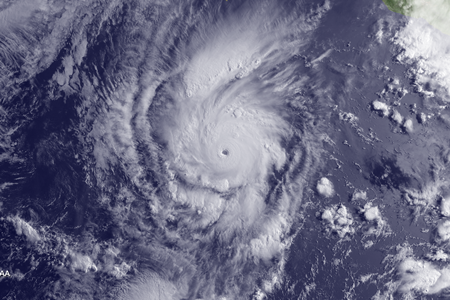North Atlantic
June 2014 Tropical Cyclone Counts
| Storm Type | June 2014 | June 1981-2010 Average | Record Most for June Period of Record: 1851-2014 |
|---|---|---|---|
| Tropical Storm (Winds > 39 mph) |
0 | 0.5 (one every other year) |
3 (1886, 1909, 1936, 1968) |
| Hurricane (Winds > 74 mph) |
0 | 0.1 (one every 10 years) |
3 (1886) |
| Major Hurricane (Winds > 111 mph) |
0 | 0 | 1 (1945, 1957, 1966) |
East Pacific
June 2014 Tropical Cyclone Counts
| Storm Type | June 2014 | June 1981-2010 Average | Record Most for June Period of Record: 1949-2014 |
|---|---|---|---|
| Tropical Storm (Winds > 39 mph) |
4 | 1.9 | 5 (1985) |
| Hurricane (Winds > 74 mph) |
1 | 0.8 (four every five years) |
3 (1984) |
| Major Hurricane (Winds > 111 mph) |
1 | 0.3 (about one every three years) |
2 (1978, 2010) |
June 2014 Individual Tropical Cyclones
| Name | Dates of winds >39 mph |
Maximum Sustained Winds |
Minimum Central Pressure |
Landfall |
|---|---|---|---|---|
| Tropical Storm Boris | June 2nd–4th | 40 mph | 999 mb | N/A |
| Hurricane Cristina (Cat. 4) |
June 9th–15th | 150 mph | 935 mb | N/A |
| Tropical Storm Douglas | June 30th– July 5th | 45 mph | 1000 mb | N/A |
| Tropical Storm Elida | June 2rd– June 4 nd |
50 mph | 1003 mb | N/A |
Summary of May 2014 Event
The following summary is for an event that occurred before the first 2014 monthly tropical cyclone report that was issued for June. Hurricane Amanda developed from a tropical depression that formed on May 22nd south of the Gulf of Tehuantepec off of Mexico's Pacific Coast, and reached tropical storm strength on the 23rd. Amanda rapidly strengthened to hurricane strength by the 24th. The hurricane reached its peak intensity late in the day on the 24th with winds of 155 mph (Category 4) and a central minimum pressure of 932 mb. Hurricane Amanda quickly dissipated to a tropical storm and a remnant low by the 29th. The largest impacts from the storm were heavy rains along Mexico's mountainous coast, which caused flooding and landslides. At least one fatality was blamed on the heavy rains. Hurricane Amanda was an usual storm for the East Pacific Basin. The storm was the second-earliest major hurricane (Category 3 or higher) for the basin, behind Hurricane Bud that reached Category 3 strength early in the day on May 24, 2012. Hurricane Amanda was also the strongest May hurricane on record for the East Pacific, surpassing Hurricane Adolph in 2001 that had maximum sustained winds of 145 mph.
 NOAA's National Centers for Environmental Information
NOAA's National Centers for Environmental Information
